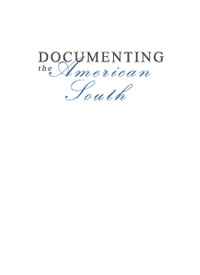Documenting the American South

Coverage Range: 1624 – 1980
Number of Records: 703
Publisher: University Library, University of North Carolina at Chapel Hill
Types of Source Material Included:
abstract or summary, art reproduction, article, autobiography, bibliography, biography, book, essay, history, interview, letter, manuscript, map, memoir, newspaper, notated music, poetry, reporting, short story, statistics
Documenting the American South is produced by the University of North Carolina to make digitized content from the UNC library’s special collections more widely available.
It contains material from four collections: The Church in the Southern Black Community, First-Person Narratives of the American South, Library of Southern Literature, and North American Slave Narratives.
Find over 700 records with full text dating from as far back as 1624 in the University of North Carolina’s Documenting the American South collection in Eight Centuries.
Documenting the American South in Eight Centuries contains four major collections from the University of North Carolina at Chapel Hill, described in detail below. These collections cover a wide scope of American history and contain material useful to researchers working in many different fields.
North American Slave Narratives
With works spanning from the 1700s through the twentieth century, North American Slave Narratives contains some of the most important eyewitness primary source material in American history: the stories and memoirs of enslaved people.
This collection brings together every known autobiography of formerly-enslaved individuals, biographies of formerly-enslaved and so-called fugitive enslaved people, and fictional slavery narratives. These materials come in many different formats: from full published books to ephemera like pamphlets and broadsheets.1
The Church in the Southern Black Community
This collection brings together material related to the history of Black church communities in the southern United States. As characterized by the UNC Library, “the story of the black church is a tale of variety and struggle in the midst of constant racism and oppression.”2
As an institution, the Protestant church was a cohesive element in many African American communities throughout the nineteenth century. This collection contains sources charting the beginnings of this institution in the actions of white Protestant missionaries, through the transformation enacted as Black Americans—enslaved as well as free—adopted aspects of the church as their own.3
First-Person Narratives of the American South
Contains a wealth of primary source documents from a variety of different southern perspectives, with especial interest placed on individuals who may have been overlooked by their contemporaries due to social standing, race, or gender.
Here find journals, diaries, slave narratives, and memoirs from marginalized groups such as Native Americans, African Americans, women, and laborers.4
Library of Southern Literature
A collection of literary works published in the American south, ranging from the colonial period through the mid-1920s. This library was based largely on a bibliography developed by Dr. Robert Bain, professor of English at UNC Chapel Hill.
Described by the UNC library as “the most important Southern literary works from the colonial period to the beginning of the twentieth century,” this bibliography includes the earliest descriptions of America by the British in the seventeenth century through writers working during the late nineteenth and early twentieth centuries.
About the Data
Each record in Documenting the American South contains a multitude of different types of metadata useful to the researcher. Subject headings added by the UNC library allow for directed searching by a regular set of terms.
Furthermore, many records contain extensive notes written by researchers at UNC. These provide important background information on the particular resource described by the record, placing it in historical and societal context.
Finally, nearly all records in Documenting the American South contain links to the full text available on the UNC library website. Along with providing additional metadata, these links send researchers to image scans of the resource, and—in most cases—corrected OCR versions of the text itself. Besides making these easier to access to the researcher, this also allows resources in Documenting the American South to be used in text/data mining applications.
Sample research topics addressed by the Documenting the American South collection, searchable via Eight Centuries:
What were the experiences of enslaved people who escaped to freedom prior to the American Civil War?
(Many examples of this exist in the source, e.g., J. W. Loguen, The Rev. J. W. Loguen, as a Slave and as a Freeman. A Narrative of Real Life, 1859)
(Daniel Alexander Payne, History of the African Methodist Episcopal Church, 1891)
(Caroline Elizabeth Thomas Merrick, Old Times in Dixie Land: a Southern Matron's Memories, 1901)
(James Williams, Life and Adventures of James Williams, a Fugitive Slave, with a Full Description of the Underground Railroad, 1873)
(Albion Winegar Tourgée, A Fool's Errand. By One of the Fools, 1879)
What was the typical experience of a Black soldier fighting for the Union during the Civil War?
(Elijah P. Marrs, Life and History of the Rev. Elijah P. Marrs, First Pastor of Beargrass Baptist Church, and Author, 1885)
[1] “North American Slave Narratives,” Documenting the American South website, accessed May 26, 2021, https://docsouth.unc.edu/neh/.
[2] “The Church in the Southern Black Community,” Documenting the American South website, accessed May 26, 2021, https://docsouth.unc.edu/church/.
[3] Ibid.
[4] “First-Person Narratives of the American South,” Documenting the American South website, accessed May 26, 2021, https://docsouth.unc.edu/fpn/.